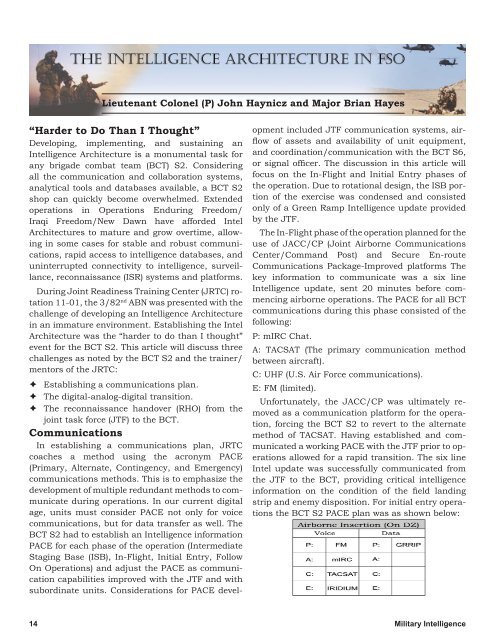George w. casey jr. - Federation of American Scientists
George w. casey jr. - Federation of American Scientists
George w. casey jr. - Federation of American Scientists
Create successful ePaper yourself
Turn your PDF publications into a flip-book with our unique Google optimized e-Paper software.
Lieutenant Colonel (P) John Haynicz and Major Brian Hayes<br />
“Harder to Do Than I Thought”<br />
Developing, implementing, and sustaining an<br />
Intelligence Architecture is a monumental task for<br />
any brigade combat team (BCT) S2. Considering<br />
all the communication and collaboration systems,<br />
analytical tools and databases available, a BCT S2<br />
shop can quickly become overwhelmed. Extended<br />
operations in Operations Enduring Freedom/<br />
Iraqi Freedom/New Dawn have afforded Intel<br />
Architectures to mature and grow overtime, allowing<br />
in some cases for stable and robust communications,<br />
rapid access to intelligence databases, and<br />
uninterrupted connectivity to intelligence, surveillance,<br />
reconnaissance (ISR) systems and platforms.<br />
During Joint Readiness Training Center (JRTC) rotation<br />
11-01, the 3/82 nd ABN was presented with the<br />
challenge <strong>of</strong> developing an Intelligence Architecture<br />
in an immature environment. Establishing the Intel<br />
Architecture was the “harder to do than I thought”<br />
event for the BCT S2. This article will discuss three<br />
challenges as noted by the BCT S2 and the trainer/<br />
mentors <strong>of</strong> the JRTC:<br />
Establishing a communications plan.<br />
The digital-analog-digital transition.<br />
The reconnaissance handover (RHO) from the<br />
joint task force (JTF) to the BCT.<br />
Communications<br />
In establishing a communications plan, JRTC<br />
coaches a method using the acronym PACE<br />
(Primary, Alternate, Contingency, and Emergency)<br />
communications methods. This is to emphasize the<br />
development <strong>of</strong> multiple redundant methods to communicate<br />
during operations. In our current digital<br />
age, units must consider PACE not only for voice<br />
communications, but for data transfer as well. The<br />
BCT S2 had to establish an Intelligence information<br />
PACE for each phase <strong>of</strong> the operation (Intermediate<br />
Staging Base (ISB), In-Flight, Initial Entry, Follow<br />
On Operations) and adjust the PACE as communication<br />
capabilities improved with the JTF and with<br />
subordinate units. Considerations for PACE development<br />
included JTF communication systems, airflow<br />
<strong>of</strong> assets and availability <strong>of</strong> unit equipment,<br />
and coordination/communication with the BCT S6,<br />
or signal <strong>of</strong>ficer. The discussion in this article will<br />
focus on the In-Flight and Initial Entry phases <strong>of</strong><br />
the operation. Due to rotational design, the ISB portion<br />
<strong>of</strong> the exercise was condensed and consisted<br />
only <strong>of</strong> a Green Ramp Intelligence update provided<br />
by the JTF.<br />
The In-Flight phase <strong>of</strong> the operation planned for the<br />
use <strong>of</strong> JACC/CP (Joint Airborne Communications<br />
Center/Command Post) and Secure En-route<br />
Communications Package-Improved platforms The<br />
key information to communicate was a six line<br />
Intelligence update, sent 20 minutes before commencing<br />
airborne operations. The PACE for all BCT<br />
communications during this phase consisted <strong>of</strong> the<br />
following:<br />
P: mIRC Chat.<br />
A: TACSAT (The primary communication method<br />
between aircraft).<br />
C: UHF (U.S. Air Force communications).<br />
E: FM (limited).<br />
Unfortunately, the JACC/CP was ultimately removed<br />
as a communication platform for the operation,<br />
forcing the BCT S2 to revert to the alternate<br />
method <strong>of</strong> TACSAT. Having established and communicated<br />
a working PACE with the JTF prior to operations<br />
allowed for a rapid transition. The six line<br />
Intel update was successfully communicated from<br />
the JTF to the BCT, providing critical intelligence<br />
information on the condition <strong>of</strong> the field landing<br />
strip and enemy disposition. For initial entry operations<br />
the BCT S2 PACE plan was as shown below:<br />
14 Military Intelligence















